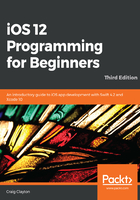
Getting Familiar with Xcode
So, you want to get into iOS development? I was in your shoes on January 27, 2010, when Apple first announced the iPad. As soon as the conference was over, I knew that I wanted to learn how to create apps for the iPad. I signed up for the Apple Developer website and paid my $99 annual fee. But then, I realized that I did not know where to begin. A large variety of instructional books or videos did not exist, especially since the iPad hadn't released. I had previous programming experience; however, I had no idea how to write Objective-C (the original programming language for iOS). Therefore, I had to teach myself the basics. In this book, we will learn what it takes to become an iOS developer together.
If you are new to programming, take your time. You should understand the lessons that are provided in one chapter before moving on to the next. These essential skills will set you up with a solid foundation in iOS development. If you have previous programming experience, you should still review the earlier chapters, as they will be a refresher for you.
Throughout this book, we will work in Xcode, specifically Xcode 10 (and Swift 4, which we will tackle later in this book). Xcode is known as an Integrated Development Environment (IDE). Using Xcode gives us everything we will need to build apps for iOS, tvOS, macOS (formerly, OS X), and watchOS. In this chapter, we will explore Xcode to help you get more comfortable using it. If you are not on Xcode 10, make sure to update Xcode, as the code in this book will not run correctly otherwise.
Our focus in this book will be on creating a universal iOS app (an app for both the iPhone and iPad). The best way to do this is to create a project to familiarize yourself with where everything is and how to find what you need. So first, let's first download and install Xcode.